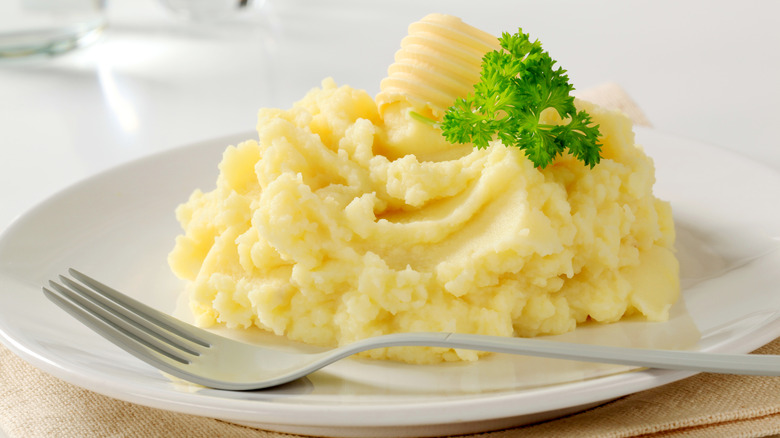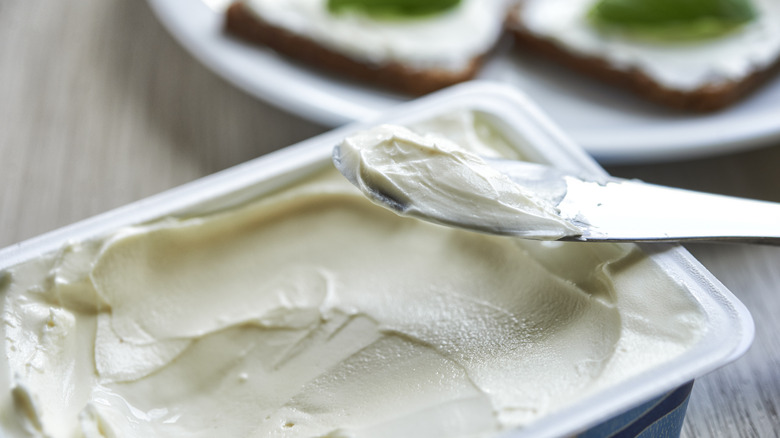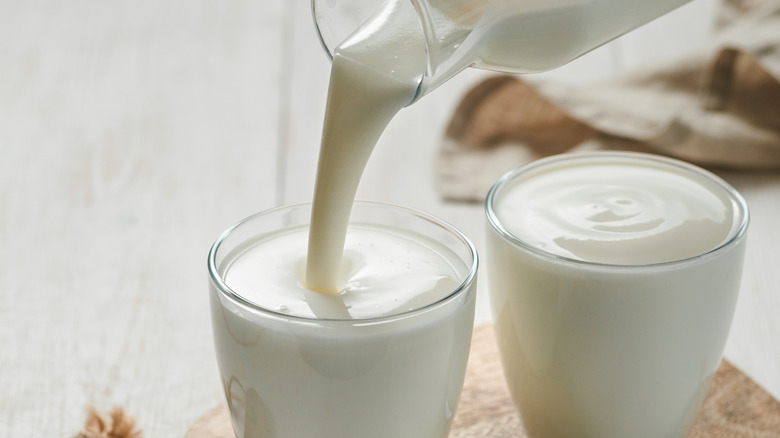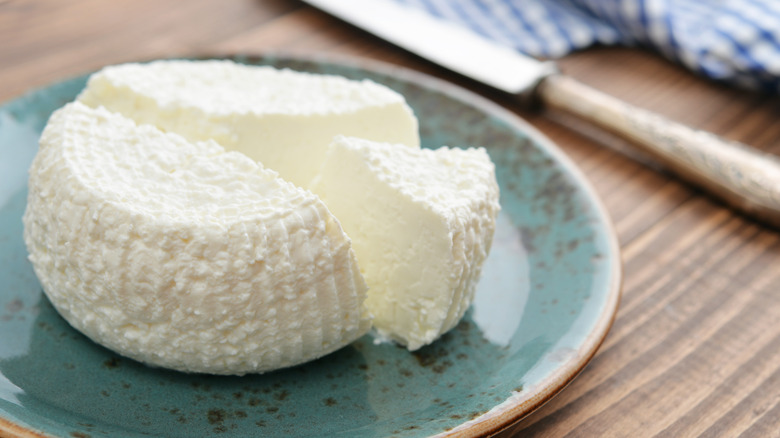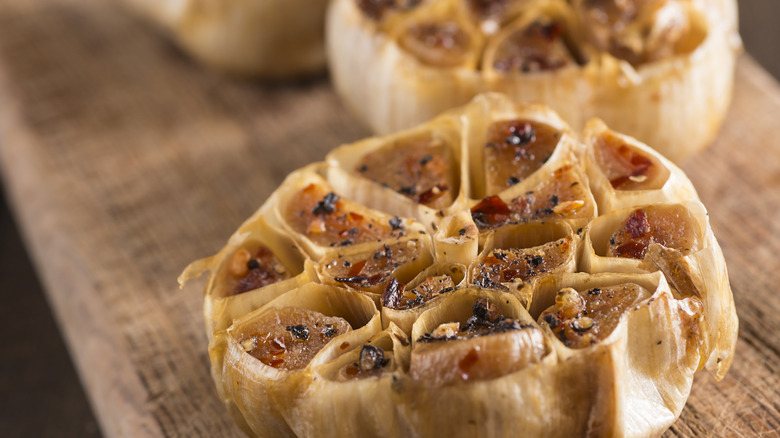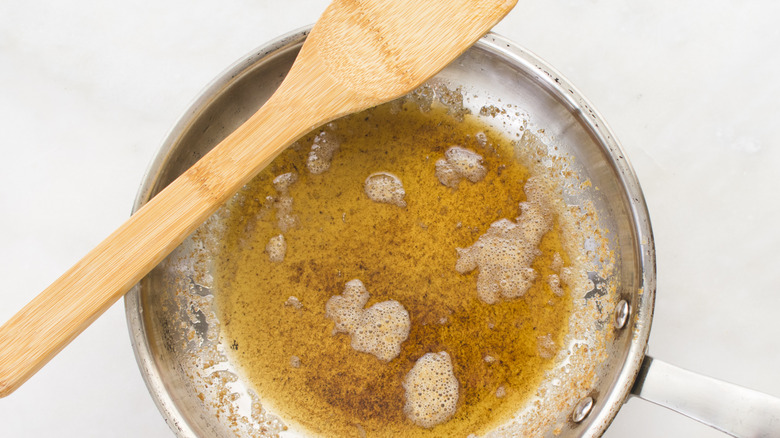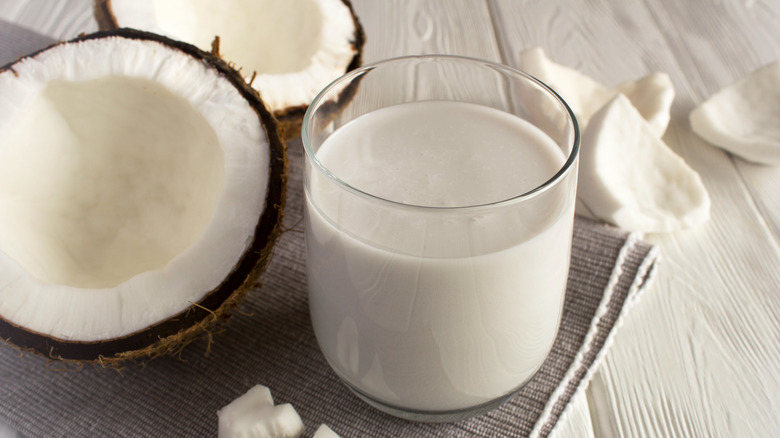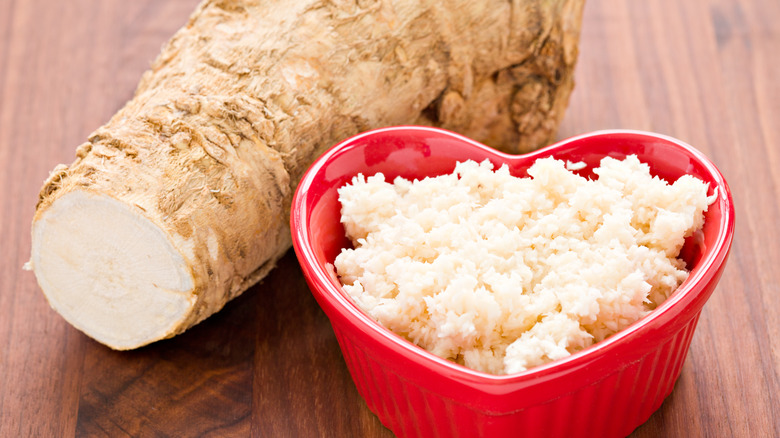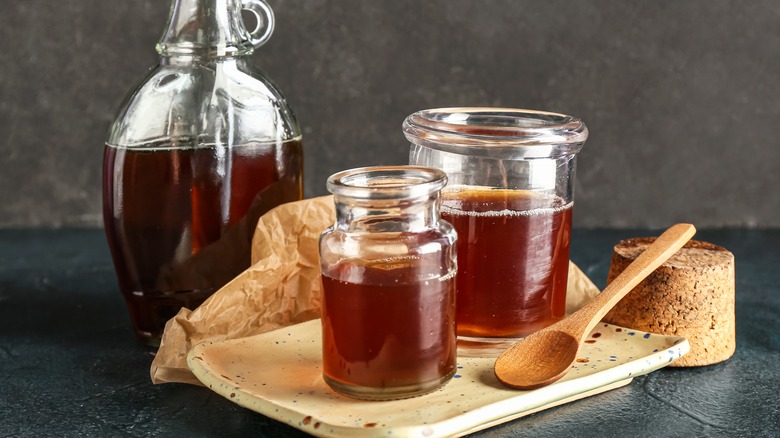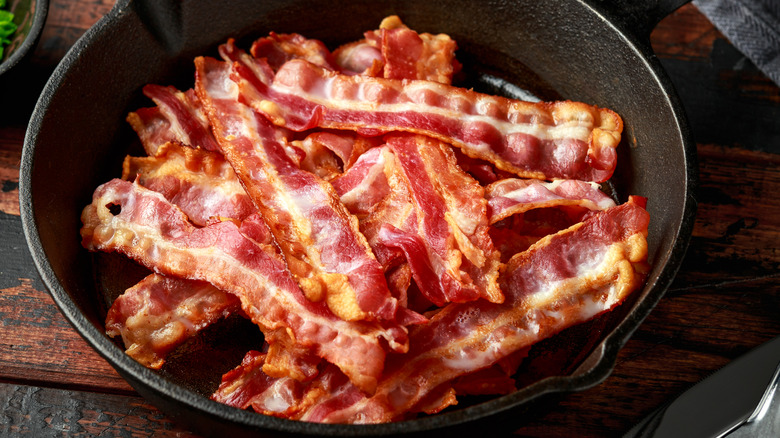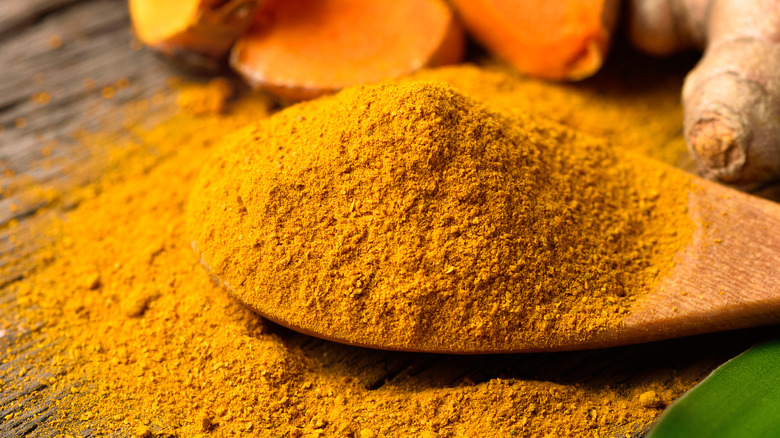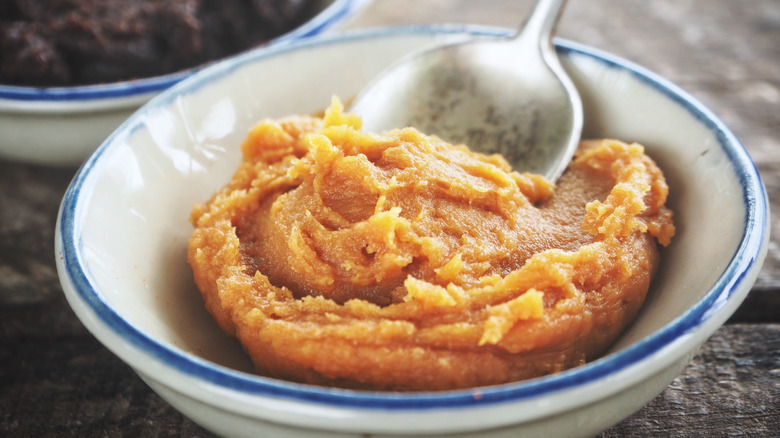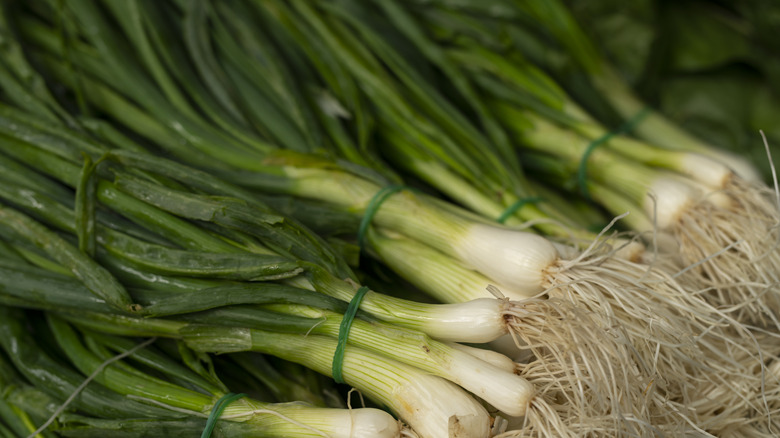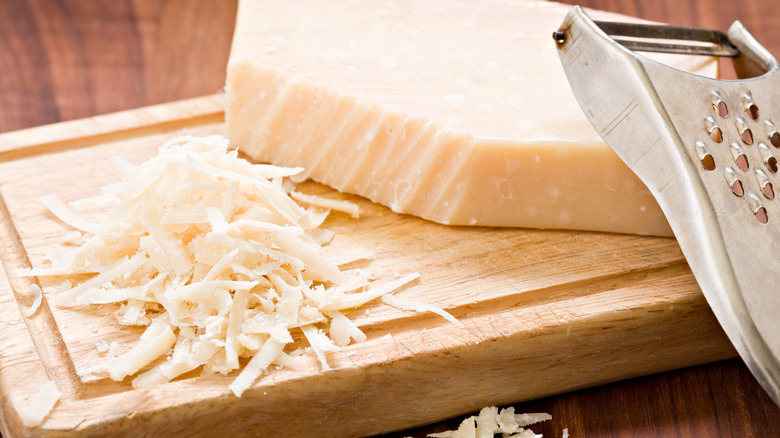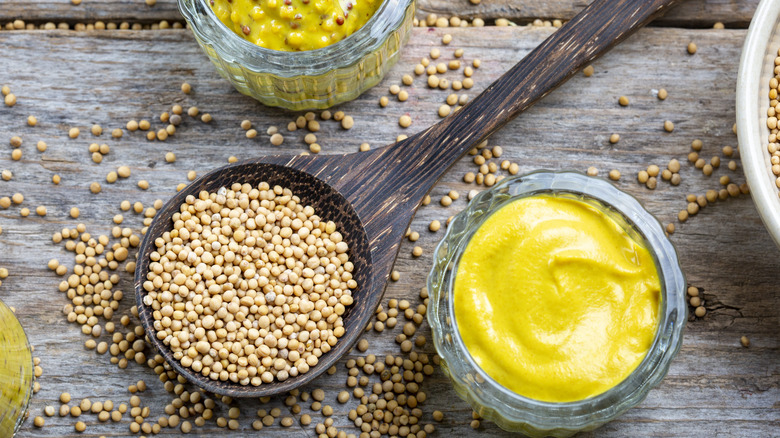14 Tasty Ingredients That Will Change The Way You Make Mashed Potatoes
Whether you're preparing Sunday dinner for the family, are rushing to whip up a quick weeknight meal, or are just craving a light, fluffy bowl of "instant comfort" as a snack, there's nothing better than a hearty serving of mashed potatoes. With their inherently creamy texture, buttery goodness, and infinite versatility, mashed potatoes pair perfectly with almost anything you can put on a plate. Just peel, boil, and mash, and you've got all the makings for an incredible, indulgent helping of this all-American classic.
While russet potatoes are often considered the best potato you can mash — especially if you're looking for incredible fluffiness — Yukon Golds and Idaho potatoes are also great options. You'll need about 2 pounds of raw potatoes, peeled and cubed, to make 6 to 8 servings of mashed potatoes. Cook your potatoes until tender, then combine them with butter (typically 2 to 4 tablespoons to start), milk or cream (½ cup to 1 cup depending on your desired level of creaminess), plus salt and pepper to taste. Then, to finish the dish, just mash or whip these ingredients until you reach creamy mashed potato perfection.
From these humble beginnings, fresh herbs like parsley or a dash of garlic powder are easy ways to take your mashed potatoes to the next level. But for a real treat — and to seriously upgrade any serving of mashed potatoes — consider these 14 essential additions, stir-ins, and flavor-packed potato "partners" that follow as well.
Make your mashed potatoes richer with cream cheese
We all know cream cheese as the soft, mild, savory spread that goes on bagels. But this cheesy combination of milk and cream is also a great cooking ingredient. It's also an ideal option to add to mashed potatoes to bring even more decadent, luxurious creaminess to the dish, giving them a smooth, velvety texture and helping to prevent dryness.
Working cream cheese into a serving of mashed potatoes couldn't be easier. You'll want to use between 4 and 8 ounces of the spread for every 2 pounds of potatoes you've cooked. Add the cream cheese to your potatoes at the same time as your butter, salt, and pepper — before mashing — and then work it in as you mash and whip the potatoes until smooth. Plain cream cheese is all you need for any mashed potato dish, but you can also experiment with chive and onion or garden vegetable blends to help pack even more flavor into your potatoes.
Cream cheese-infused mashed potatoes are excellent as a side for herb-roasted chicken, grilled steak, salmon fillets and so much more.
Add tang with buttermilk
Like cream cheese, buttermilk is another wonderful option to add richness and creaminess to any bowl of mashed potatoes. In addition to added creaminess, buttermilk can also bring tang to your potatoes as well. The liquid — a leftover by-product of making butter — has a distinctive sharp, sour bite and provides mashed potatoes with a more refreshing, lively flavor quality — it can help them seem sweeter, more dynamic, and more complex. The tang of buttermilk also helps to balance the richness of butter and cream, making mashed potatoes seem less dense and heavy.
For an average serving of mashed potatoes, you can simply swap the milk or cream from your original recipe and use buttermilk in its place. You'll need approximately ½ to 1 cup for around 2 pounds of cooked potatoes.
To make buttermilk at home (if you don't have any on hand in the fridge), just combine 1 cup of milk with 1 tablespoon of lemon juice or white vinegar. Stir well and let sit for five to 10 minutes before use. This gives the milk time to curdle and thicken.
Make your mashed potatoes lighter and fluffier with ricotta cheese
Just as buttermilk is the liquid left over during the production of butter, ricotta is a byproduct of cheese production — it's the "whey" or liquid that remains after milk has been curdled and strained away from various types of cheese. To transform this liquid into something more useable following that straining process, that whey is reheated and paired with different acids or enzymes. The resulting product is an altogether different and unique tangy soft cheese the Italians lovingly call ricotta.
Besides being an essential part of pasta dishes like spinach and ricotta lasagna, ricotta cheese can be a superstar addition to any bowl of mashed potatoes. Once stirred in, it adds richness, creaminess, and a fluffy airiness to mashed potatoes that you can't get from any other ingredient.
To work ricotta cheese into mashed potatoes, boil or steam your potatoes until they are tender and can be mashed easily with a fork. Next, drain them and let cool slightly. Add your still-warm potatoes to a large bowl along with between ½ to 1 cup of ricotta cheese, 2 to 4 tablespoons of butter, and salt and pepper to taste. Finally, whip everything up to just the right level of creaminess using a potato masher or electric mixer. You can add an additional splash of milk or cream if needed if you want your potatoes to be even richer or smoother.
Amp up mashed potato savoriness with roasted garlic
After dairy substitutions, roast garlic is one of the most impactful and delicious ingredients around to bring even more flavor to this classic dish. Roast garlic provides mashed potatoes with a robust, complex sweetness and nuttiness. It creates a natural contrast to the savoriness of the potatoes and helps them taste more cozy and satisfying — like a nice warm hug on a plate.
To add this comforting flavor to your mashed potatoes, you'll first need to slow roast a head of garlic in the oven until the individual cloves are soft, caramelized, and have become more mellow and sweeter tasting (instead of being so bitter like fresh, raw garlic). Once roasted, remove 2 to 3 garlic cloves from the head. Mash them into a paste and fold them into your already creamy mashed potatoes. Stir well until the garlic is evenly mixed into the dish, taste it, and add more garlic as needed.
Use brown butter for even more delicious butter flavor
Ever let some butter melt in a skillet a little longer than intended? If so, congratulations — you've just made brown butter or "beurre noisette," as the French call it. This rich, nutty, golden-brown liquid is no culinary mishap. Instead, it's a widely loved popular ingredient known for its deep, distinctive flavor. And it's an incredible option to add to mashed potatoes to make them even silkier, more fragrant, and filled with the rich, mouthwatering taste of butter.
You can add between 2 and 4 tablespoons of brown butter to any course of mashed potatoes you might be preparing. Just fold the rich liquid in and keep stirring until evenly spread throughout the dish.
If you find yourself using brown butter frequently, you might also consider stocking up on a bottle of ghee. Ghee is butter that has been melted and "clarified." The milk fats or excess liquid is removed, leaving only pure butterfat. Ghee packs the same buttery richness of brown butter and is also a wonderful addition to mashed potatoes, although it lacks some of the nuttiness you might get with brown butter.
Create tropical 'taters with added coconut milk
More than just a staple of making pina coladas, coconut milk can be used in all kinds of savory cooking preparations. You can use it to make incredible Thai green curry, golden chicken and lentil soup, and coconut sticky rice. You can also use coconut milk to make velvety-smooth, vegan, or plant-based mashed potatoes that are not only dairy-free but also pack a subtly sweet, tropical twist.
Swap coconut milk into mashed potatoes in a one-to-one ratio for any dairy you might have otherwise used. For 2 pounds of cooked potatoes, that means you would need between ½ to 1 cup of coconut milk. Add it to your cooked, slightly cooled potatoes, plus salt and pepper to taste, and mash and whip until you reach your desired potato consistency. Coconut mashed potatoes are an incredible option to pair with curry dishes of all types, grilled seafood, lime and cilantro chicken, or even your favorite vegetarian stir-fry.
Give your potatoes some zest with horseradish
A member of the Brassicaceae family of produce — and cousin to veggies including mustard, wasabi, broccoli, cabbage, and radishes — horseradish is a pungent root beloved for its strong and spicy flavor. It can be ground into a powder that's used as a spice or turned into a condiment-like sauce. Either way, both are great options for stirring into mashed potatoes, transforming grandma's classic comfort food into a spicy, aromatic side that's oozing with flavor and bite.
Remember, a little horseradish goes a long way, even when mixed into a starchy veggie like mashed potatoes. Start with 1 teaspoon of ground horseradish powder or 1 tablespoon of prepared horseradish sauce and work that into your mashed potatoes to start. Then, if you like the flavor and want even more punch, add more to taste.
Horseradish mashed potatoes are the perfect side to pair with roast beef. These bold 'taters also go exceptionally well with grilled sausage, pork tenderloin, or even salmon fillets. Or, for similarly zesty potatoes with a bit less bite, you could also use ground ginger in place of horseradish for a slightly more mild alternative.
Add a touch of sweetness with maple syrup
A natural sweetener collected from the sap of maple trees in later winter or early spring and then boiled to form a concentrated, golden syrup, maple can be a surprising and unexpectedly delicious addition to any bowl of mashed potatoes. Maple syrup is ideal for adding cozy, comforting caramel-like notes to mashed potatoes. It provides sweetness to the dish that is savory and earthy without being cloying or overpowering.
Maple-infused potatoes are perfect with herb-filled dishes like holiday roast turkey, bacon-wrapped pork tenderloin, or even pecan-encrusted chicken — dishes that are rich and savory and that would benefit from a hint of sweetness and depth to round out and amplify their flavors. If you think a dish would go well with a side of cranberry sauce, then maple syrup mashed potatoes are also a perfect menu option.
To add maple syrup's subtly sweet and rich flavor to your mashed potatoes, purchase some pure maple syrup — not that imitation stuff some people pour over their pancakes. That way, you can be sure you're getting that pure, rich caramel flavor instead of something that is synthetic and artificial. Start by stirring 2 to 4 tablespoons of the syrup into your already whipped potatoes. Give them a taste, and then — if you're looking for more sweetness — drizzle in even more syrup as needed.
Bring on the smoke with crumbled bacon
Another way to draw inspiration from breakfast — and add incredible flavor to your mashed potatoes — is with freshly cooked, crumbled bacon. Of course, bacon really does make anything taste better. But it's an especially great addition to mashed potatoes. The rich, savory, slightly smokey flavor of bacon is an ideal complement to the mild, starchy, earthy taste of potatoes. The protein also provides a wonderful textural contrast, adding crispness and crunch to mashed potatoes. And bacon also contains super tasty fats that add to the mouthfeel of the potatoes, making them seem even more luxurious and satisfying.
Cooked bacon can be crumbled or diced and folded directly into any bowl of prepared mashed potatoes. Use as little or as much as you want; this is one ingredient you can't go wrong with adding. You can also select between smoked bacon, peppered bacon, center cut or thick cut, and even candied bacon — all work equally well in mashed potatoes, and each variety of bacon brings unique qualities to the dish. Diced pancetta and even turkey bacon are also good options, with the latter also being a slightly leaner, lower-calorie option.
Boost mashed potatoes naturally with your favorite spices
Potatoes are one of the few foods that work well with almost any spice you might think to pair them with. And because of their thick, rich consistency, mashed potatoes, in particular, take on the flavors of different spices and spice blends better than almost any food imaginable.
The time to add spices to a mashed potato recipe is when you are combining your potatoes, salt and pepper, butter, and dairy — before the potatoes are mashed and whisked together to fluffy perfection. Regardless of the herb or spice you use, start with 1 teaspoon. Taste your mashed potatoes once they are whipped together, and then add more of the spice as needed.
Curry powder is a wonderful mashed potato addition, providing warmth and intense depth to the dish. Go with paprika for hints of a beautiful red color and mild smokiness. Nutmeg gives potatoes a warm, nutty sweetness. Dill and coriander pack a bright, citrus-like bite. Celery salt can bring added savory flavor to mashed potatoes, and turmeric will not only turn your potatoes a lovely shade of yellow but will also bring out a slight earthiness that can be quite unexpected and tasty. Cumin, thyme, rosemary, cayenne, basil, chervil, and marjoram are also excellent mashed potato options, as is garam masala. This popular Indian spice blend combines cinnamon, cardamom, cloves, cumin peppercorns, and more, creating a beautiful symphony of flavors in any bowl of mashed potatoes.
Magnify their salty goodness with a dash of soy sauce or miso paste
Another fun way to add depth and flavor to mashed potatoes — and amplify that salty quality that so many of us enjoy — is with classic Asian culinary staples like soy sauce or miso paste. Both condiments are made from fermented soybeans, and each packs a beautiful, savory, salty, and umami-rich flavor profile ideal for flavoring mashed potatoes.
Both products can be added either before your potatoes are mashed or folded in or after they are fully whipped if you're looking for a quick flavor boost. For soy sauce, pour 1 to 2 tablespoons directly into your mashed potato bowl and then stir well. If you use miso paste instead, dissolve 1 tablespoon of the paste in an equal amount of water, stir well, and then work that diluted mixture into the mashed potatoes. This will help to ensure the flavor is evenly dispersed and mixed well.
If you enjoy Asian flavors and have a well-stocked fridge, you can also try using other related condiments in a similar way. Sesame oil, rice vinegar, mirin, oyster sauce, fish sauce, hoisin sauce, and even gochujang (fermented chili paste) are also great options for any flavor and punch to a traditional bowl of mashed potatoes.
Add crunch with fresh shallots or green onions
Mashed potatoes can sometimes seem overly heavy or dense, especially in the warmer months of the year. One great way to overcome this and give your mashed potatoes a sense of freshness and vibrancy is with the crunch of diced chives or green onions.
While raw, diced onions might be too sharp and bitter to eat — even when whipped into a bowl of mashed potatoes — green onions, and chives don't have the same problem. They provide the delicious flavor of onion in a more mild and palatable form. Plus, because they can be finely chopped or diced and stirred directly into a bowl of mashed potatoes, they also contribute wonderful fresh veggie crunch and crispness to mashed potatoes. This helps to break up the texture of the mashed potatoes, so they don't seem so dense, and also provides texture and variety to the potatoes as you eat them, improving their mouthfeel and making them even more satisfying.
Stir in some umami flavor with truffle oil or Parmesan cheese
Along with sweet, sour, bitter, and salty, umami is one of our five basic tastes. People describe it as a savory or meaty flavor that rounds out the overall taste of a dish. In addition to beef and pork, we also get umami flavor from mushrooms — and parmesan cheese. And that's why grated parm is such an excellent flavor addition to all kinds of mashed potato dishes. It gives the potatoes an additional savory quality and an even richer flavor, even if they are already loaded with butter and cream. Plus, the older and more aged the parmesan is, the more umami flavor it packs!
To add umami's bold, deep flavor to mashed potatoes, first make sure you start with good quality parmesan cheese. That means cheese you grate yourself, not something you shake out of a bottle. You can add as little or as much parmesan to your mashed potatoes as you'd like. Just grate the cheese finely over the bowl — the smaller the pieces of cheese, the more evenly you can spread its flavor — and mix well.
Try stirring caramelized onions into your potatoes, or top them with a drizzle of your favorite truffle oil for even more umami goodness.
Give your potatoes a bite with mustard seed or wasabi
Finally, when it comes to ingredients that will seriously upgrade your mashed potatoes, don't sleep on ingredients that pack a lot of added heat. Mustard, for example, is an exceptional addition to almost any bowl of mashed potatoes. Besides its lovely tang, this classic spice and condiment also brings zest and bite and even a bit of sizzle to mashed potatoes.
You can stir 1 or more teaspoons of ground mustard powder or 1 or more tablespoons of prepared mustard directly into any bowl of mashed potatoes. Dijon mustard, spicy yellow mustard, and brown or English mustard, in particular, are all known for their robust, spicy flavor and sometimes even their intense sinus-clearing heat. This fierce flavor will lessen some when worked into a bowl of mashed potatoes, but still, be sure to start with a small amount and work up so your mashed potatoes don't end up being hotter than you can handle.
Like mustard, wasabi paste is equally spicy and potent and can also be an excellent addition to mashed potatoes. Because this paste is so thick and packs such a concentrated level of heat, add it to your potatoes when you first mash them — and if possible, whip them with an electric mixer instead of mixing by hand so you can be sure the wasabi is evenly distributed and that there are no lumps lurking within your mashed potatoes. Super easy; incredibly delicious.

